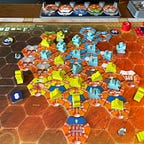Board Games
My Favorite Euro Games #3 — A Feast for Odin
“Puzzle together the life of a Viking village as you hunt, farm, craft, and explore.”
Designer by Uwe Rosenberg Art by Dennis Lohausen
A game for 1–4 players, plays in 30–120 minutes, for ages 12+
As I continue delving into my favorite Euros, it’s been hard to select which one I want to write about next. Favorites imply the ones I like most, but these games often have such different styles that it’s hard to say I like one better than the other.
It certainly wouldn’t be a legitimate list without a game by Uwe Rosenberg, and this is my favorite Rosenberg game by a wide margin.
Theme — A Viking Saga
A Feast for Odin lets players recreate the lives of ancient Scandanavian villages as they gain cultural achievements, go on trading expeditions, and pillage and raid neighboring villages!
This game shows us that Vikings weren’t only fearsome warriors and that they participated in many of the same practices from all over the world. From farming, raising livestock, fishing/whaling, making clothing, to building ships — Vikings lived varied lifestyles as demonstrated rather well in A Feast for Odin.
Game Mechanics
1. Worker Placement
AFFO’s infamous worker placement board has garnered polarizing opinions. At first glance, the choices are certainly overwhelming (more than 60 action spots!) but they are broken down into rows of common action types. The categories of actions you can take include:
- build houses
- build ships
- hunting
- livestock market
- weekly market
- products
- crafting
- mountain & trade
- sailing
- emigration & occupation.
After selecting one of these categories, players will decide how many of their Vikings they want to place. A 1-Viking action might be very efficient but a 4-Viking action will be more powerful. Players must keep a close eye on what their opponents are up to. The placement you were hoping you could take at the end might get snatched up because an opponent really wanted that placement as well.
2. Polyomino Placement
Players will gain a variety (and I mean a lot!) of different polyomino tiles over the course of the game. These will be placed on various boards, including the personal player board and other boards the players have acquired. The polyominos must be carefully placed to allow for the most efficient or streamlined strategies, which will allow players to snowball their resources.
The various player boards contain resources like hack silver, wood, stone, ore, and variously shaped goods tiles. Players will surround symbols on their boards to trigger “income” during the harvest phase. These polyomino tiles also serve to cover the ubiquitous -1 spots all over the player boards.
Players will not only fill in their personal player board that depicts their very own Viking village. They can also acquire longhouses, islands, and various huts to gain endgame victory points and to get an ever-expanding income.
3. Engine-Building
As in many other Rosenberg games, players must “feed” their workers during an end-of-round harvest phase. In the beginning, players will only be able to cover a small part of their boards and must use a large portion of their tiles to feed their Vikings. As players expand out, their silver income and goods should increase, making the feeding phase almost trivial. This is where a lot of players have a real love for this game; gaining all of those tiles and hack silver pieces during the harvest.
4. Dice-Rolling
Oddly enough, this game has much more dice-rolling and push-your-luck elements than most other Eurogames. This comes in the form of the powerful hunting, whaling, raiding and pillaging actions. These have a “push your luck” element that some players lean into and others avoid. Players have a number of ways to mitigate bad luck. They can use ore resources to increase the strengths of their roles, or use the various occupation cards that help buff the chances of success.
What I Like About A Feast For Odin
- There are many ways to play and no obviously dominant strategy. Your cards, dice results, turn order, and personal preferences will all shape the way your game will be played.
- The feeling of building something is very satisfying. Filling up the various islands and houses feels like I’m accomplishing something. Looking at my board at the end of the game can be quite picture-worthy!
- The neat polyomino goods tiles are well depicted and properly thematic.
- There is a game “weight” and skill level required to improve and it feels good when you realize you are playing better and better.
Why You Might Not Enjoy AFFO
- It’s an AP-prone game. So many choices can lead to lots of downtime if players aren’t considering their options between turns.
- The game can feel overwhelming at first, and sometimes you won’t understand why you lost very badly.
- It’s very fiddly and heavy on bits like cards, tiles, dice, etc.
- Games can run long.
- The best player is very likely to win.
- The game isn’t cheap.
My Favorite Euro Games #3 A Feast For Odin
That’s the quick and easy version. Of course, there’s much more to this game. Maybe that will be for future articles to delve into. = )
If you like these types of articles or others I have written, please do me a solid and click “follow” or get my articles by email when I release them. It’s free!
-the BoardGameNerd
